Days of Wine and Roses was written by Henry Mancini in 1962 for the movie of the same name. The song has since become a jazz standard and popular among jazz guitarists with recordings from Joe Pass, Barney Kessel, Lenny Breau, Bill Frisell, Jimmy Raney, John Abercrombie, Howard Roberts, and many more. The most famous jazz guitar recording is Wes Montgomery’s version on his album Boss Guitar (1963).
In this lesson, you will learn a solo over the chord changes of Days of Wine and Roses.
This solo features some classic jazz patterns, including patterns that mix chords and single-note lines. To learn more jazz patterns like those used in this solo, check out our course Jazz Guitar Patterns & Phrases Volume 1.
Recommended listening:
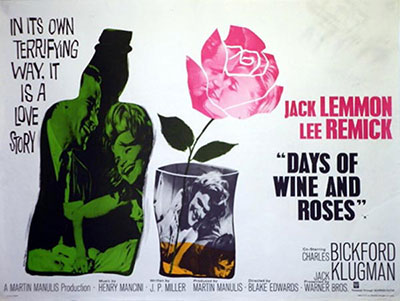
- Wes Montgomery – Boss Guitar (1963)
- Barney Kessel – Just Friends (1975)
- Joe Pass – Easy Living (1986)
- Bireli Lagrene – Standards (1992)
- Bill Frisell – East/West (2005)
- Dexter Gordon – Tangerine (1972)
- Keith Jarrett – Keith Jarrett at the Blue Note (1995)
- Bill Evans – Consecration (2002)
Video
Guitar Tabs/Notation
Backing Track
Listen & Play-Along
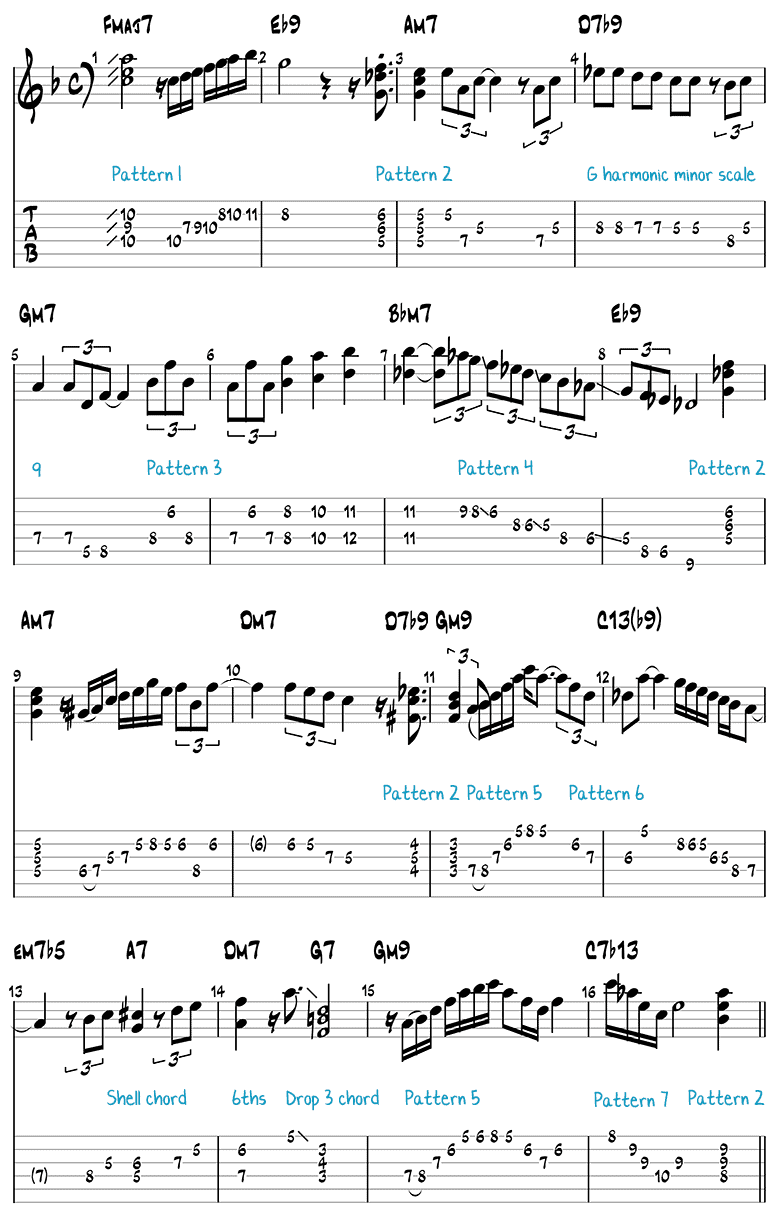
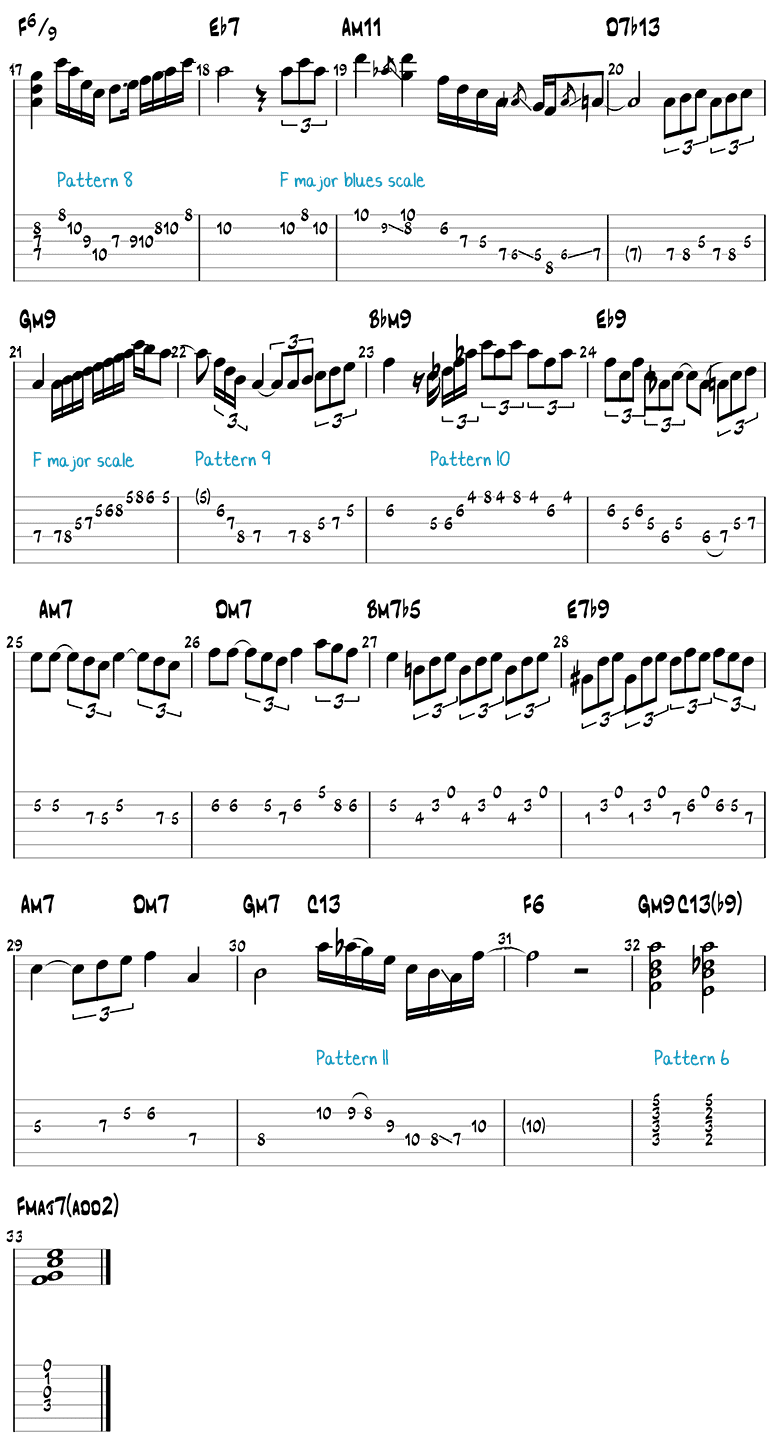
Jazz Guitar Patterns
Let’s have a closer look at the patterns used in the solo.
Pattern 1 (bar 1)
This first pattern can be used to mix chords into your single-note lines.
You start with a chord voicing and then play the appropriate scale starting on the 5th and ending on the 9th.
This pattern can be used on major chords:

It can also be used on minor chords, such as in this II V I progression:

Pattern 2 (bar 2, 8, 10, 16)
The most natural place to mix chords into your solos is on the 4th beat of a dominant chord and the 1st beat of the chord it resolves to.
In the following examples, the chord voicings are played on the B, G, and D strings. These small voicings are easy to fret and don’t get in the way of the bass or the melody/solo.
Here is an example (bar 8):
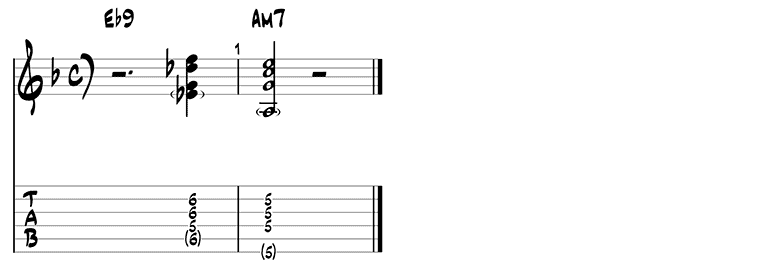
To add some variety, you can play the dominant chord after the beat (bar 2):
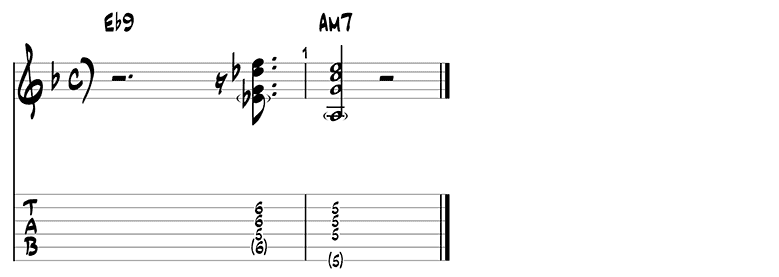
In this example (bar 10), I use a 7b9 voicing:

In bar 16, I use a 7b13 chord to go to the tonic major:
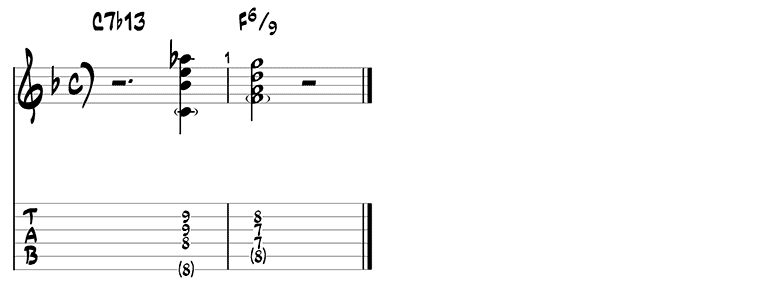
Pattern 3 (bar 6)
In bar 5, I use 6th intervals to bring a touch of harmony in between the single-note lines.
Here is an exercise to practice playing 6th intervals in scales.
On the E-string:

On the A-string:

On the D-string:

On the G-string:

Pattern 4 (bar 7)
Pattern 4 uses slides to navigate through the Bb Dorian mode.

You can apply this principle to other scales as well, such as the C major scale.

Pattern 5 (bar 11)
A Bbmaj9 arpeggio is a common way to play over G minor chords, resulting in a Gm11 sound.
Playing a maj9 arpeggio from the 3rd of a minor chord brings out the 9/11 sound.
For example: Bbmaj9 over Gm7.
| Bbmaj9 arpeggio | Bb | D | F | A | C |
|---|---|---|---|---|---|
| Played over Gm7 | b3 | 5 | b7 | 9 | 11 |
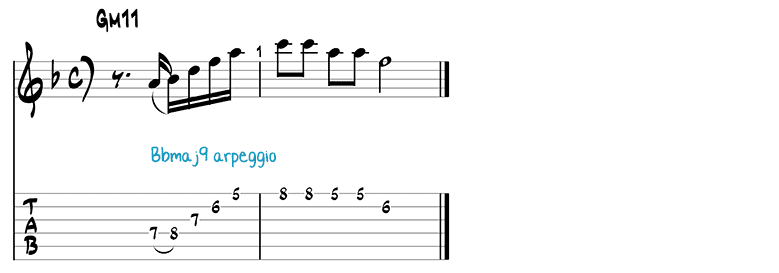
Pattern 6 (bar 12, 32)
Pattern 6 starts with the same substitution as pattern 5.
In bar 2 I play the b9 and 13 of C7:

The scale of choice to play over 13b9 chords is the dominant diminished scale, also known as the half/whole diminished scale because it alternates between half and whole steps in its interval structure.
| Dominant Diminished | 1 | b9 | #9 | 3 | #11 | 5 | 13 | b7 | 1 |
|---|---|---|---|---|---|---|---|---|---|
| H | W | H | W | H | W | H | W |
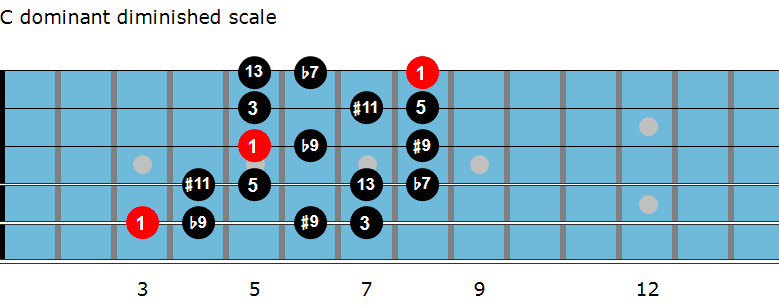

Here are two examples of how you can get this sound into your comping as well:
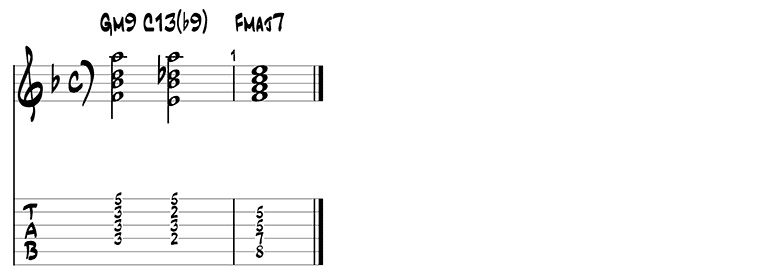
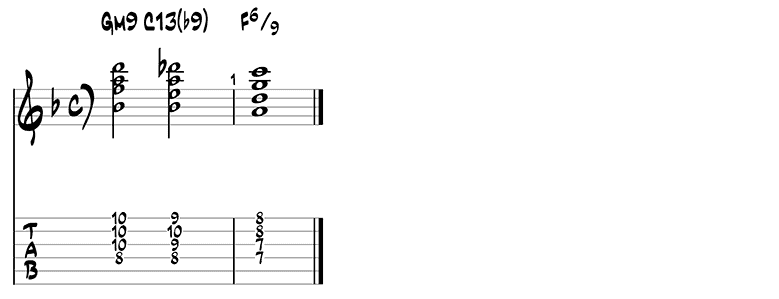
Pattern 7 (bar 16)
Pattern 7 uses a C augmented triad to play over C7b13.
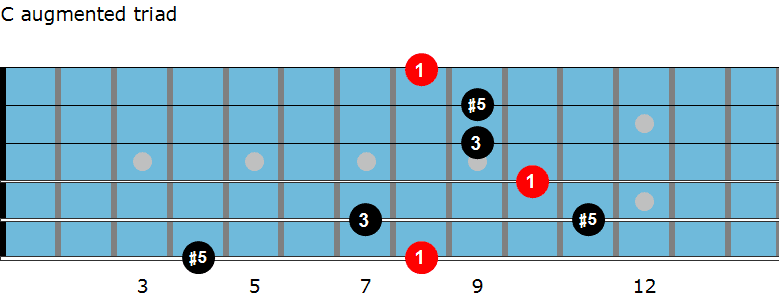

Pattern 8 (bar 17)
The next pattern is a variation of a pattern Wes Montgomery uses in his solo over Days of Wine and Roses.
It uses an A minor triad to play over Fmaj7, a simpler version of the substitution in pattern 5.
Note how this pattern outlines an Fmaj7 chord shape.
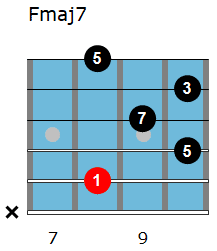

Here is the original version of this pattern in Wes Montgomery’s solo (0:06 in the Wes video below).
Note that he uses Ebmaj7 instead of Eb7 in bar 2 of the form.
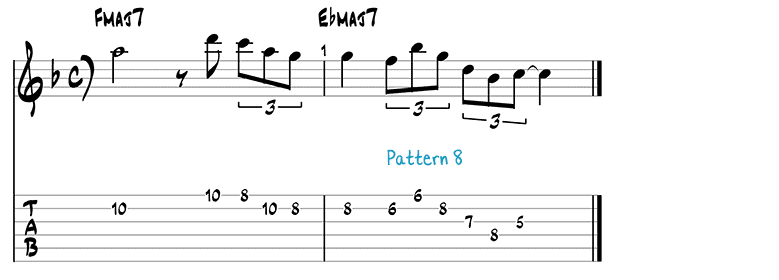
Pattern 9 (bar 22)
Pattern 9 is a typical jazz guitar cliché that applies an uprake to a maj7 arpeggio (same substitution as pattern 5).
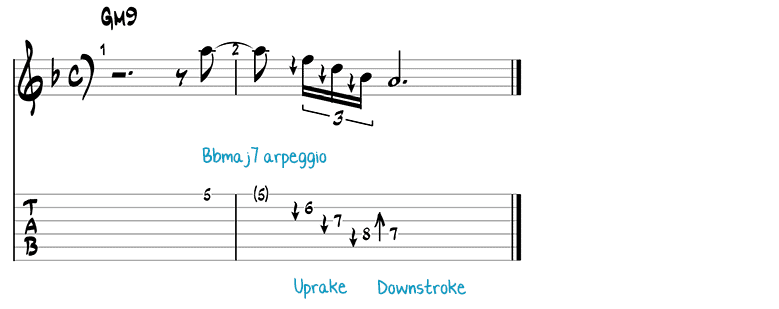
Pattern 10 (bar 23)
Pattern 10 starts with a Dbmaj7 arpeggio over Bbm7 (see pattern 5) and continues with an F minor triad (see pattern 8).
| Fm triad | F | Ab | C |
|---|---|---|---|
| Played over Bbm7 | 5 | b7 | 9 |

Pattern 11 (bar 30)
This last pattern outlines a C13 chord.
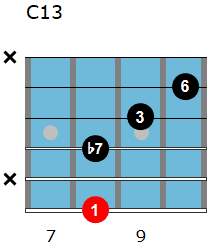

Here is a variation on the same pattern:

Days of Wine and Roses Guitar Pro File
Days of Wine and Roses Band in a Box File




Salut, merci Sincèrement Dirk pour ton excellent travail, ta générosité, ton partage. Je passe mon temps à travailler ou plutôt à m’amuser avec les fantastiques outils que tu mets à notre disposition. Tu es un seigneur tu iras direct au paradis.
Thank you so much for these lessons; well presented, keeping me busy. My question: What amp are you using on “Days of Wine And Roses”?
Hi Pam, I’m using a Fender Tone Master Twin Reverb here, great amp!
Thank you!
Magnifica lección, con buenos recursos e ideas para la improvisación. Gracias.
Masterful. So nice to hear your technique and choice of voicings.
Thank you Dirk for another wonderful arrangement and playing of a classic standard. You have great talent.
Hi Dirk! Many thanks for this awesome, generous lesson. Your interpretation is truly of a Wes’ disciple. I’ll open a bottle of wine to enjoy it even more. Still waiting for your album with some of the great jazz standards you play so well. Cheers from Brasilia! All the best, Pedro
Salve Dirk , che dire della tua bravura … sempre sorprendente ,varia , accurata , mai banale e tanto altro . Grazie grazie per gli insegnamenti che regali
Excelente trabajo. Muchas gracias maestro.
Alweer een schitterend arrangement
I really enjoy the analysis. I think the feature of your teaching is the lengths you go to in explaining complex elements of songs. I’ve always luv’d Days of Wine and Roses but found it challenging to solo over because of the multiple dominants. Your explanatory material helps to increase my understanding. Thanks
Would it be possible to get this solo as pdf-file?
Hi Vesa, use the “Print & PDF” button at the bottom of the lesson.
Hi Dirk, you have done very good professional work. It was three months
ago that i can’t played, cause i was ill (not corona). Now I try to hurry
to get same level with other pupils. I’m now practicing Ellington’s Night Train. I try also play classical guitar at the same time
So I’ve been busy with guitar playing.
I would like to know which theorical material will read.
The band in a box is very good thing and thank you the tutorial
material you give.
regards
Arto
I don’t understand how pattern 9 works, I can’t get it to sound the same as in your recording…
Hi Tom, the uprake requires some practice to get it smooth. The first three notes are sweep-picked downwards, the fourth note is a downstroke.
Thanks Dirk, great solo and material to work on! When is your new course ready?
The course will be published the second week of December. I’ll let you know!
Hi Dirk, good lesson well explained and plenty to work with.. I enjoyed reading and listening so thanks.
AMAZING
Thanks, I’m glad you like it!